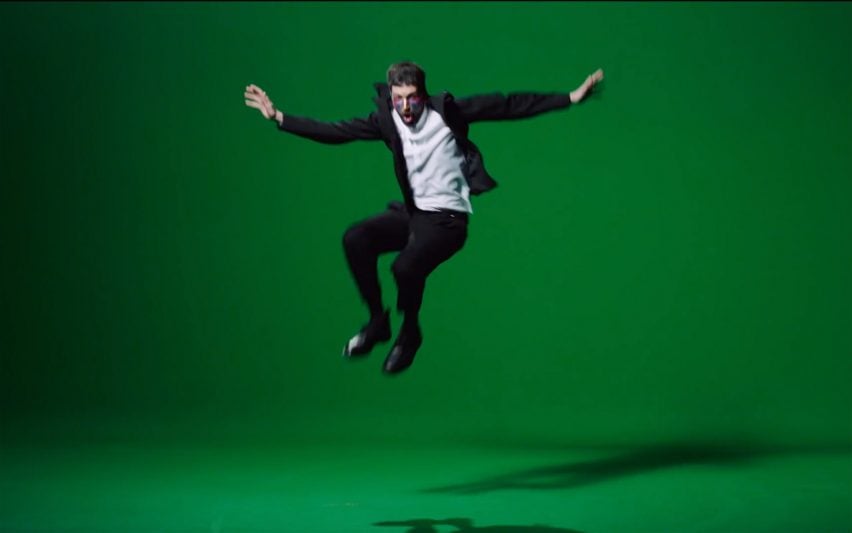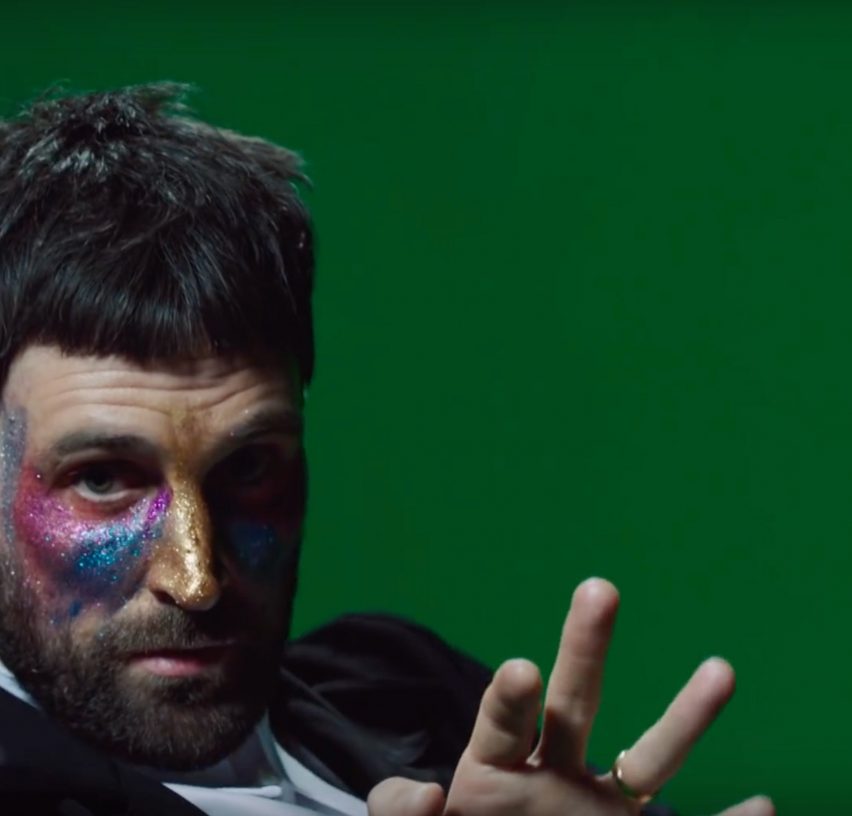Aitor Throup develops "speed-warping" technique for The SLP music video
Kasabian's Sergio Pizzorno had to sing in a "crazy" mix of slow and fast speeds to achieve the glitchy effect in the music video for Favourites, directed by designer Aitor Throup.
Throup, who is primarily known for his fashion design, used a unique mix of editing techniques he collectively calls "speed-warping" in his direction for the video for the first single from The SLP – Pizzorno's solo project.
It sees Pizzorno dancing sometimes in slow motion, sometimes sped up and sometimes in reverse, all while appearing to sing lyrics in real time.
Throup has been experimenting with speed-ramping and time remapping techniques in video editing for some time, and when his long-time collaborator Pizzorno played him Favourites, he knew it was the right moment to attempt a more ambitious application.

"I always wanted to develop a way to incorporate speed-ramping and time remapping into an actual performance," he told Dezeen.
"I think that showing the body moving in a supernatural way yet keeping in time to a 'real-time' song is a poetic way of challenging how the viewers perceive what they are seeing."
Throup's speed-warping process is labour-intensive. It starts with a common technique, where the song is altered to be a third faster and the performer learns to lip sync it at this speed. The idea is that, by performing it this way but filming at the faster rate of 33 frames per second (fps), the video will have a dream-like slow-moving feeling when played back at the normal 25 frames per second fps.
Pizzorno had to lip sync de-constructed track
However, Throup didn't film at this moment. This is because he wanted to include moments of speed ramping, which is when the video ramps up smoothly into a higher speed and back down.
He also wanted to incorporate time remapping, where portions of footage are not just compressed or expanded but frozen or reversed. This is what gives Favourites its glitchy, stop-start look.
Instead, he deconstructed the audio track to include slowed-down moments that could be ramped up to look like they are being sung normally in the video edit. Sometimes that meant isolating and tweaking sections of audio that were just half a second long.
And Pizzorno had to learn to lip sync this patchwork, Frankenstein's monster version of the track, which Throup describes as "crazy" and "actually pretty difficult to listen to".
"[It] meant basically making decisions that you would typically make in the edit before you even shoot anything," Throup said of the process. "It was a huge challenge for Sergio to perform to, but I would say it was an even bigger challenge for us to actually de-construct and re-construct the original track."
Intention is viewer can't understand
The result is an aesthetic that's both lo-fi and fantastical, with Pizzorno performing impossible-looking choreography against a plain green background. Halfway through, the video shifts into a simpler mode with the arrival of guest vocalist, rapper Little Simz.
"My intention was that the viewer doesn't actually understand or actually perceive what is happening — but subconsciously they feel that there is something new and unusual about what they are seeing: something that hopefully matches perfectly the feeling they get from the song itself," said Throup.

The Argentine-born British designer rose to prominence for his work in fashion — he is the former executive creative director of denim brand G-Star RAW and has his own label, New Object Research — but he's also long been involved in music and video.
He is creative director of Pizzorno's band Kasabian and has worked with Damon Albarn on video and art for the album Everyday Robots. In 2014 he directed a short film titled A Portrait of Noomi Rapace, with a score by Flying Lotus, for the online portal Nowness.
Read the full interview with Throup below:
Rima Sabina Aouf: What was the genesis of this video, and how did the idea evolve?
Aitor Throup: I have actually been thinking about developing this technique for around five years. When Sergio played me the track it was clear to me instantly that this was the right time to bring it out. I have always enjoyed playing with speed-ramped movements in the edit, but I always wanted to develop a way to incorporate speed-ramping and time re-mapping into an actual performance.
I think that showing the body moving in a supernatural way yet keeping in time to a real-time song is a poetic way of challenging how the viewers perceive what they are seeing.
I'm always interested in creating something new — for me, this mainly centres around product and garment design, but in this instance, I was interested in challenging the conventions of movement in a video context.
This also applies to the movement of the camera: there are times when we speed ramp through a huge camera movement in the space of half a second whilst keeping in time to the song. My intention was that the viewer doesn't actually understand or actually perceive what is happening — but subconsciously they feel that there is something new and unusual about what they are seeing: something that hopefully matches perfectly the feeling they get from the song itself.
Rima Sabina Aouf: If I understand the technique correctly, Sergio had to learn to lip sync the song both faster and slower than its actual tempo for the shoot. Does that mean there's a glitchy fast-slow version of the track somewhere that he'd practice from?
Aitor Throup: Yes that's right — there's this really crazy version of the track that is actually pretty difficult to listen to. It was a huge challenge for Sergio to perform to, but I would say it was an even bigger challenge for us to actually deconstruct and reconstruct the original track.
Once I decided the exact moments of the track that I would speed ramp, we had to isolate those exact beats (around half a second) and extend by what I thought would be the perfect amount of frames/duration to create the effect that I wanted.
What made it more difficult was that the track itself when we weren't slowing it down for the speed-ramps, had to be sped up to a third faster than the original tempo. This gives the performance a very slight slow-motion effect, as we captured everything at 33 frames per second.
In actual fact, the whole process was like a Frankenstein of different informed guesses which could only be tested to a certain degree. We just had to go into the shoot itself with a certain amount of confidence, but the truth is that we didn't know exactly what would come out.
Rima Sabina Aouf: You had to choose the speed ramp moments before shooting a single frame of video, with just the third faster audio track to work with. So how do you choose these speed ramp moments? What are the rules and goals you set?
Aitor Throup: For me it's about feeling what parts of the song dictate a certain feeling. I want to create a sort of visual glitch that matches what you are hearing. This meant basically making decisions that you would typically make in the edit before you even shoot anything.
We were backing ourselves into corners continuously. I think that this kind of approach always leads to something interesting. I suppose it's about relinquishing control — giving yourself to a process that forces you to accept certain things.
I have tried to manifest this philosophy of creation throughout all of my work. I create certain rules or systems, and then I simply follow them to the best of my ability. If you are authentic to that process and fight the temptation to fix the imperfections, I believe it's the closest we can get to replicating nature through art: there's an archetypal ideal, but the variables mean that imperfections dictate the eventual result. It's about placing the importance of process higher than that of the product.
Rima Sabina Aouf: The effect reminds me a bit of Coldplay's The Scientist video, which Chris Martin recorded singing backwards. What were the touchstones or influences for you in making this video?
Aitor Throup: I love that video. I suppose I am interested in the same essence that gives that video its life source. There are so many beautiful nuances and imperfections created by the process that give a very authentic value to the final aesthetic.
Moments like that are always inspiring for me. It can happen in film, in music, in product. My whole work is about creating those moments: new and unique experiences that look a certain way because of something.
I think that true innovation — or even simply 'newness' — is a significant tool in cultural and societal evolution, not only because of how a specific example expands our possibilities but more importantly because moments like that empower us to remember that we can always break out of the system. My objective is to unlearn what is normal or what we deem possible.
I want to challenge my ego constantly by daring to take risks — be it through processes or aesthetics — that might seem counter-intuitive because they don't capitalise on easy opportunities for success. I think this is why I find it so natural to work with Sergio. We are both prepared to take those risks, and we encourage each other to go further.
Rima Sabina Aouf: The process sounds incredibly laborious — why choose this over, for example, CGI?
Aitor Throup: Because it's real. I believe that we are so visually desensitised because of CGI and VFX that it's hard for us to experience something visually that feels new or at least intriguing. We simply accept everything.
I love what CGI can do, but I'm more interested in creating anatomically layered processes which eventually result in something that is to some degree out of my control. CGI is all about controlling the end result. I suffer from an incredibly overactive mind which can easily take over my work and my life. I suppose I use any opportunity to not control every tiny little detail. I want to have certain things to work with which are out of my control.
In the end, I will use my highly controlled approach to optimise the result, but if I control every single element too much the product can become stale. I really believe in the concept of breathing life into something by creating anatomically, from the inside outwards — starting with an idea or a concept, which in turn informs a process or processes, which eventually gives way to a final product.
If you can trace back the eventual result to "reason" it means that the designer relinquished some control to something that is bigger than an individual's sense of taste.
Rima Sabina Aouf: You haven't used the speed-warping technique in the Little Simz part of Favourites — why?
Aitor Throup: As you can imagine, Simz is incredibly busy and we had to be clever about how we used the time we had with her. The whole pre-ramping process is incredibly laborious and it was simply too time consuming to apply it to Simz' part.
I also love that when she comes in she has this really sophisticated energy that swiftly navigates through her verse effortlessly, which the ramps might have compromised. To be honest with you, both Sergio and I were impressed enough on the day of the shoot that she was able to so effortlessly perform the song at the third faster tempo.
We had prepared that version just in case she felt comfortable with it. She only had to try it out once and she nailed it. This meant that we could film her at 33 frames per second which gives her performance the same slightly surreal slow motion that Sergio's performance has throughout.